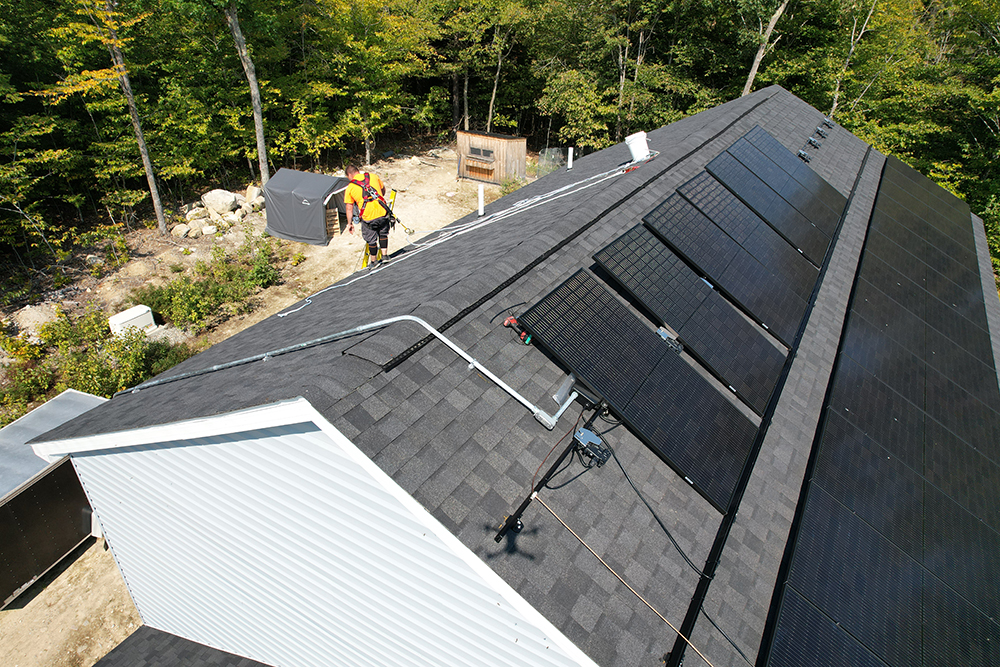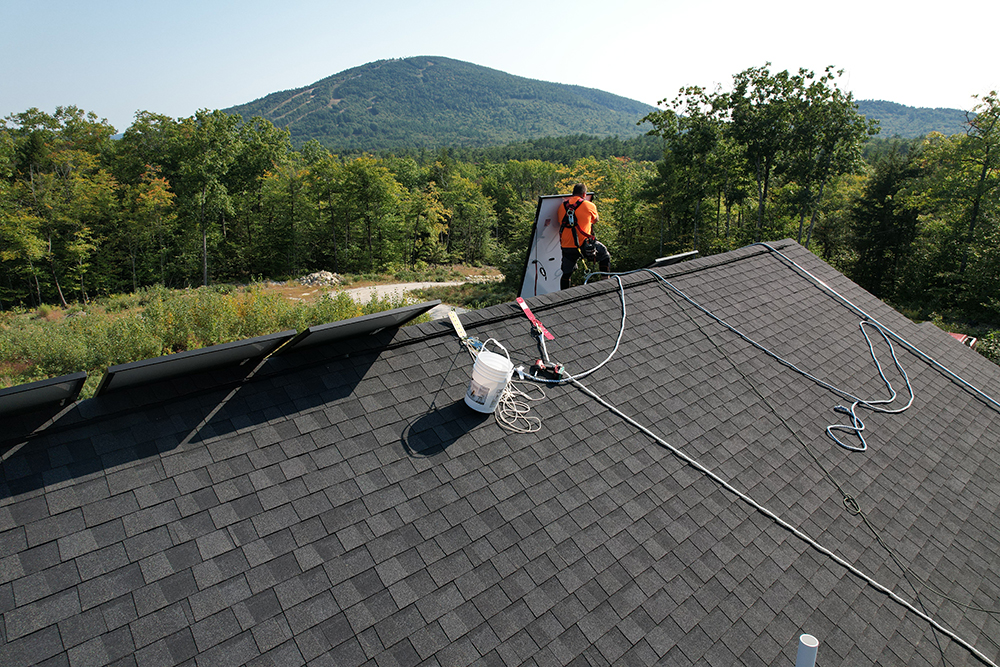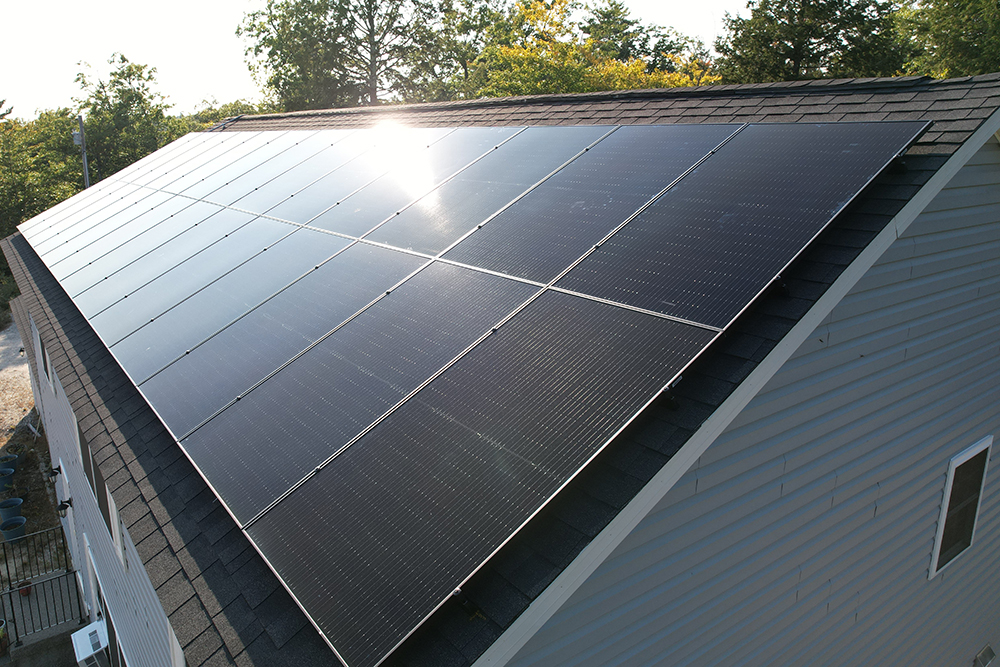Grid Tied Systems
Grid Tied Systems are by far the most common type of solar installation, and for good reason. They have many advantages that homeowners love.
They are a very simple system and don’t require you add any components accept the solar system itself. Any home that is already connected to the utility grid and has good exposure to the sun can take advantage of these systems.
Sizing your system properly is a crucial part of our process that will have the largest impact on your satisfaction with your system. The goal of sizing your system is to design a system that, as close as possible, produces exactly the amount of power you will use. This doesn’t mean that every day your system will produce the energy you use that day though. We want to look at yearly energy production and consumption. This allows us to take advantage of “Net Metering”. In the summer months, when the sun is strong and the days are long, your system will produce more power than you are using. While you won’t get paid for the extra power but the power company will issue you a credit for the power you over produced. Then in the winter months, when the sun is weaker and the days are shorter, you will likely not produce as much energy as you are using. This will allow you to use the credits that you banked during the summer months.
These credits do expire after a year so we don’t want to make the system too large and waste a bunch of energy. However we do recommend trying to make the system large enough to provide some margin in case we have a year with a lot of cloudy days, or a lot of snow.
While grid tied systems are great they do not provide power during a power outage. In fact they are required to have an automatic shut off that shuts down the system if the utility power goes out. While this seems a bit counterintuitive, it is actually for a very important safety reason. Without this protection a lineman from the power company could be working on lines seem to be dead when all of a sudden the sun comes out and the solar system begins to feed power to the utility lines. This would be a major safety hazard for the men and women that are working to restore power.
Contact us to learn more about the options we can provide.
Battery Backup
A battery backup is a great option to give you power during a utility power outage. This is a common addition to a grid tie system, as well as an integral part of an off grid system. A battery back up system for a grid tie system is able to provide backup power during a power outage as well as keep you from using utility power during the night. We can look at various options when sizing your battery backup system depending on your budget and how long you want to have backup power during an outage.
In an off grid system the battery backup is an integral part of the system rather than an optional add on. In a standby system we will need to work with you to get a very accurate picture of your power consumption. The general rule for sizing a battery back up in an off grid installation is to make it last 3 days without any charging. But this is only a general rule and will vary depending on whether you are putting this system on a weekend camp or a primary residence. This is when we get to have a great time together educating and running scenarios to help you make the best decision for your situation. Call us today to learn more.
Off Grid Systems
This is a less common type of installation, but when you get way out there headed upta camp, it may just be the bast fit. An off grid solar system can consist of solar panels, a battery backup, and a standby generator. The basic operation is as follows:
The home is always running off of the batteries. As the solar panels are producing power they charge the batteries, if your batteries get low and the panels are not producing enough power to charge them the charge controller will turn on the standby generator and the standby generator will charge the batteries. Sizing of the components of an off grid system is even more important than a grid tied system. If this system over produces it will not gain you credits like a grid tied system, but if it is underproducing there is no grid power to rely on. So if you are looking for an off grid system we will spend quite a bit of time making sure we get an accurate picture of how much power you plan to use and may even need to consider the pros and cons of multiple system sizes. Contact us today to learn more about your options.
Pricing
Without getting overly technical we need to point out that the price and performance of any solar system depend on a great number of variables. Just a few of these variables for a roof top solar system are things like the orientation of your roof, the pitch of your roof, the size of your roof, and shading concerns. Some of the things that effect the price of a ground mounted solar array would be distance from the house, the location of the solar array, and space constraints. There is no way to know the exact price of your system without doing a site visit and preliminary design but lets look at some averages:
The average home in Maine has an electricity bill between $180 and $250 per month. Solar systems to offset that amount of electricity are between $20,000 and $30,000. However don’t forget about the 30% federal tax credit for going solar! That means a $20,000 solar system would have a net cost of $14,000 and a $30,000 solar system would have a net cost of $21,000! See the chart below for some ideas of what your system could cost:
| Average Monthly CMP Cost | Estimated Annual Consumption* | Solar Array Size | Estimated Solar Purchase Price** | Net Solar Price After 30% Tax Credit |
|---|---|---|---|---|
| $140 | 6,431 kWh/year | 5 kW Array | $15,490 | $10,843 |
| $195 | 9,000 kWh/year | 7 kW Array | $20,990 | $14,693 |
| $280 | 12,860 kWh/year | 10 kW Array | $29,780 | $20,846 |
| $395 | 18,000 kWh/year | 14 kW Array | $38,380 | $26,866 |
*Your exact usage can be found on your bill, we would be happy to help you find that information.
**These prices are only general estimates. Your exact pricing and solar system production will vary depending on your specific project and conditions.
The prices above are based on a grid-tie rooftop solar system install. While these are the most common types of solar systems there are other options like grid-tie with battery backup, ground mounted solar arrays, off-grid stand-alone solar systems, and hybrid solar systems that include another power source such as a generator or windmill. These alternate solar systems are very design specific and small design choices can make a very large difference in price. If you are interested in one of these solar systems, please contact us so that we can guide and educate you on the best options.



